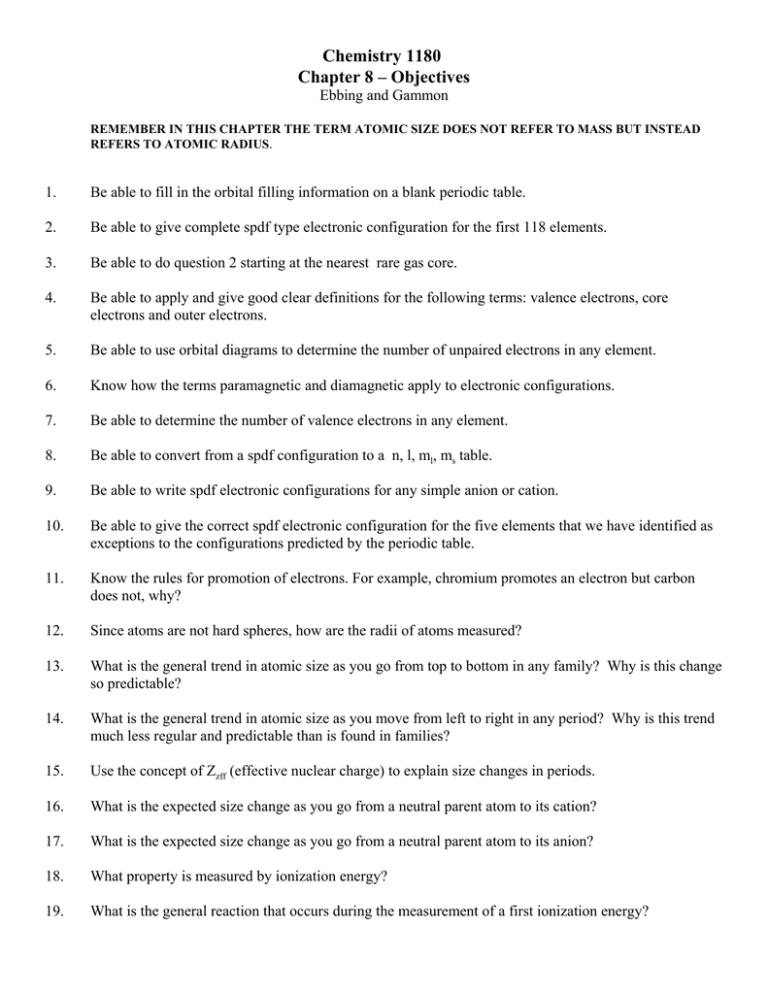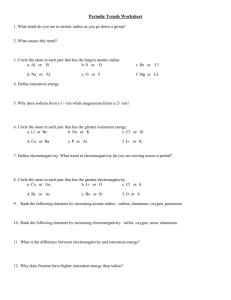Chemistry 1180 Chapter 8 – Objectives Ebbing and Gammon
advertisement

Chemistry 1180 Chapter 8 – Objectives Ebbing and Gammon REMEMBER IN THIS CHAPTER THE TERM ATOMIC SIZE DOES NOT REFER TO MASS BUT INSTEAD REFERS TO ATOMIC RADIUS. 1. Be able to fill in the orbital filling information on a blank periodic table. 2. Be able to give complete spdf type electronic configuration for the first 118 elements. 3. Be able to do question 2 starting at the nearest rare gas core. 4. Be able to apply and give good clear definitions for the following terms: valence electrons, core electrons and outer electrons. 5. Be able to use orbital diagrams to determine the number of unpaired electrons in any element. 6. Know how the terms paramagnetic and diamagnetic apply to electronic configurations. 7. Be able to determine the number of valence electrons in any element. 8. Be able to convert from a spdf configuration to a n, l, ml, ms table. 9. Be able to write spdf electronic configurations for any simple anion or cation. 10. Be able to give the correct spdf electronic configuration for the five elements that we have identified as exceptions to the configurations predicted by the periodic table. 11. Know the rules for promotion of electrons. For example, chromium promotes an electron but carbon does not, why? 12. Since atoms are not hard spheres, how are the radii of atoms measured? 13. What is the general trend in atomic size as you go from top to bottom in any family? Why is this change so predictable? 14. What is the general trend in atomic size as you move from left to right in any period? Why is this trend much less regular and predictable than is found in families? 15. Use the concept of Zzff (effective nuclear charge) to explain size changes in periods. 16. What is the expected size change as you go from a neutral parent atom to its cation? 17. What is the expected size change as you go from a neutral parent atom to its anion? 18. What property is measured by ionization energy? 19. What is the general reaction that occurs during the measurement of a first ionization energy? 20. What is the general trend in first ionization energy as you move from top to bottom in any family? Why is this trend so regular and predictable? 21. What is the general trend in first ionization energy as you move from left to right in any period? Why is this trend so irregular? 22. Use the concept of Zeff and electron configuration stability to explain the experimentally observed values for first ionization energies in a period. 23. Nearly every period has two elements that have anomalous first ionization energies. Where do you expect these anomalies to occur. Can you explain why these anomalies occur? 24. What property is measured by electron affinities? 25. What is the general reaction that occurs when electron affinities are measured? 26. Why are the electron affinities of the nitrogen family so unusual? 27. How do we rationalize that the electron affinities of the halogen family are so negative? 28. What is electronegativity? 29. What is the general trend in electronegativity in a family? 30. What is the trend for electronegativity in a period? 31. In general how do the electronegativities of metals compare to the electronegativities of nonmetals? 32. What are the general characteristic properties of metals? 33. What are the general characteristic properties of nonmetals? 34. What is meant by the term “basic” solution? 35. What is meant by the term “acidic” solution. 36. What type of oxides form basic solutions? 37. What type of oxides form acidic solutions? 38. What is meant by the term “strong base”? 39. What is meant by the term “strong acid”? 40. Name several elements that form strong basic oxides. 41. Name the elements that form amphoteric oxides. 42. Be able to predict the relative strengths of simple acids. 43. Be able to predict the relative strengths of oxy-acids of the same element. 44. Be able to predict the relative strengths of oxy-acids of different elements.




